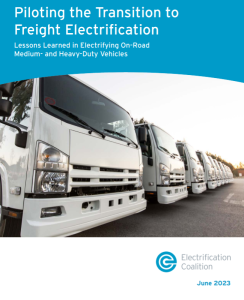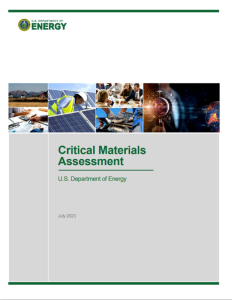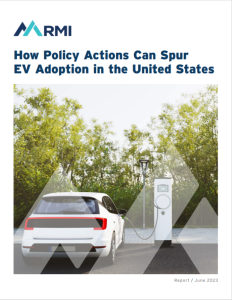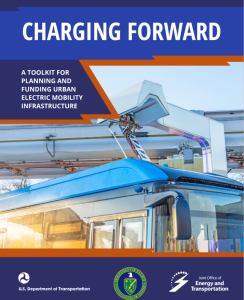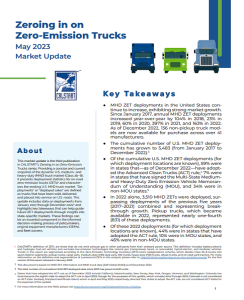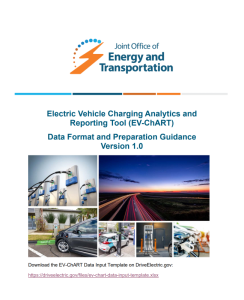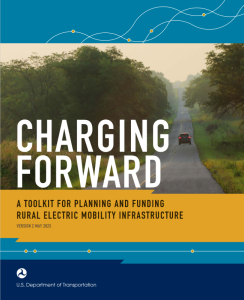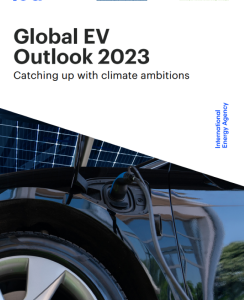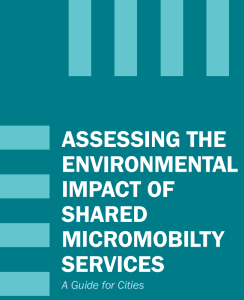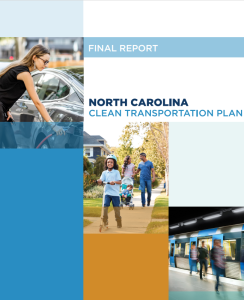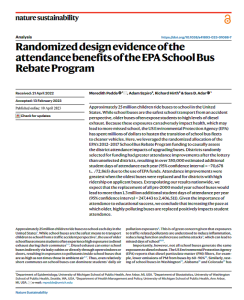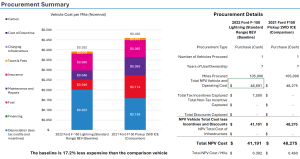We’ve assembled a comprehensive library of web-related resources related to the EV market, including reports, websites, and tools. New content is constantly hitting the web. To add a resource, simply fill out this form and we’ll add it to the library!
Filter by Date
Filter Selections:
July 2023
Transitioning to electric freight vehicles offers corporate shippers and carriers one of the best opportunities to mitigate their emissions while reducing the demand for oil in the U.S. transportation sector. The following sections outline the national and economic security, environmental, health, equity, and cost-saving benefits of shifting the transportation sector from oil to electric-based.
July 2023
With the adoption of zero-emission buses increasing across the United States, transit agencies are faced with real challenges for future energy management and increasingly detrimental consequences in the event of utility grid outages. Microgrids, which are systems that use a variety of distributed energy resources and energy storage assets, provide numerous benefits over conventional approaches to resiliency. This report breaks down how microgrids not only ensure an uninterruptible power supply but will also work to offset utility costs as demand for and the cost of electricity increases in the coming decade. The top five high-level factors that transit agencies must consider for microgrids on a project-by-project basis, plus examples of real-world transit microgrid projects, are also included.
July 2023
Plans for the national EV charging network will be shaped by a seminal study from the National Renewable Energy Laboratory (NREL), which has been at the forefront of assessing EV charging needs and developing state-of-the-art analytical tools for over a decade. In this study, researchers estimated the number, type, and location of chargers needed to create a comprehensive network of EV charging infrastructure, one that can support an anticipated 30–42 million EVs on the road by 2030.
July 2023
This new research from NRDC focuses on policies that support the most effective strategy to limit the harms from battery supply chains: reducing the type and amount minerals needed.
July 2023
The Assessment focuses on key materials with high risk of supply disruption that are integral to clean energy technologies.
June 2023
Governments, policymakers, businesses, and utilities will need to work together closely to realize the full potential of the IRA. RMI’s report How Policy Actions Can Spur EV Adoption in the United States, provides stakeholders with the analysis they need to make data-informed decisions, detailing the challenges facing IRA implementation and ways forward.
June 2023
The Urban Electric Mobility Toolkit serves as a one-stop resource to help urban communities scope, plan, and identify ways to fund electric vehicle (EV) charging infrastructure, supporting diverse forms of electric mobility including travel by personal vehicle, transit, micromobility (e.g., electric bicycles and scooters), and ride-sharing services. Urban communities, metropolitan planning organizations (MPOs), transportation providers, businesses, and property owners and developers can use the toolkit to identify key partners for an electric charging project, take advantage of relevant planning tools, and identify available funding or financing to help make that project a reality.
June 2023
As established by the Infrastructure Investment and Jobs Act, also known as the Bipartisan Infrastructure Law, the Joint Office of Energy and Transportation (Joint Office) is setting the vision for a national charging network that is convenient, affordable, reliable, and equitable to enable a future where everyone can ride and drive electric. This report supports the vision of the Joint Office by presenting a quantitative needs assessment for a national charging network capable of supporting 30–42 million PEVs on the road by 2030.
May 2023
Kevala's NEVI Parcel Finder Dashboard allows you to scan a state to discover qualified parcels for the development of EV charging.
May 2023
The third publication in CALSTART’s Zeroing in on Zero-Emission Trucks series, this market update highlights the continued increase in medium- and heavy-duty (MHD) zero-emission truck (ZET) deployments in the United States.
May 2023
Policymakers, manufacturers, and end users have experimented with a number of policy tools to promote first clean and now primarily zero-emission vehicle adoption. An expanding number of states and regions have adopted a now well-proven policy tool to efficiently deploy zero-emission commercial vehicles—and now infrastructure—faster using an innovative and flexible point-of-sale incentive: the voucher incentive program (VIP).
May 2023
Focused on the top 20 light-duty vehicle manufacturers in the world by sales in 2022, this report adds an important missing piece to global research and analysis regarding how today’s major automakers are transitioning to zero-emission vehicles (ZEVs). Our rating is quantitative and transparent; we present full details of our chosen methodology and data sources. Additionally, the ICCT contacted all the automakers assessed in this report to seek to verify the data we collected.
May 2023
Growth in the electric vehicles (EV) market within the past decade has led to increased demand for publicly accessible EV charging stations across the United States. In response, significant funding from governments, electric utilities, and private investors has been committed to install public charging stations nationwide. Total announced and awarded investments have especially accelerated in recent years, nearing $20 billion by early 2023.
May 2023
This EV-ChART Data Format and Preparation Guidance provides a comprehensive overview of the data reporting requirements as authorized under 23 CFR 680.112. The guidance is intended to be used alongside the EV-ChART Data Input Template, which defines the tabular data structure that these data submissions must follow.
May 2023
The electrification of medium- and heavy-duty vehicles (MHDVs) is gaining momentum
in the United States, and the major manufacturers in the country have made ambitious
commitments for the mass production of zero-emission vehicles (ZEVs) as early as
2030. State-level regulations such as California’s Advanced Clean Trucks (ACT) rule,
federal incentives in the Inflation Reduction Act, and the U.S. commitment to join the
Global Commercial Drive to Zero (aimed at 100% ZEV sales by 2040) are increasing
ZEV adoption in the MHDV sector. Electrifying transportation nationwide will require
the deployment of charging (for battery electric vehicles) and refueling (for hydrogen
vehicles) infrastructure, as well as the supporting electrical grid infrastructure. MHDV
fleet operators, electric utilities, and policymakers alike are uncertain as to where, how
much, and by what year charging and refueling infrastructure needs to be built, and
what upgrades to grid infrastructure are required to enable this deployment.
May 2023
Armed with the resources in this toolkit, rural communities will have the tools and information they need to start planning and implementing EV infrastructure projects and ultimately realize the benefits of electric transportation
May 2023
Using economic modeling from 2024 to 2040, this report discusses the employment effects of Michigan’s auto industry shifting from internal combustion engine vehicle manufacturing to electric vehicle manufacturing, with a focus on supporting a just transition for workers and communities.
May 2023
Zero-Emission Trucks: The Facts provides a concise overview of the state of zero-emission freight vehicles in the U.S., including industry demand, supply, and benefits.
April 2023
Electric car markets are seeing exponential growth as sales exceeded 10 million in 2022. A total of 14% of all new cars sold were electric in 2022, up from around 9% in 2021 and less than 5% in 2020. Three markets dominated
global sales. China was the frontrunner once again, accounting for around 60% of global electric car sales. More than half of the electric cars on roads worldwide are
now in China and the country has already exceeded its 2025 target for new energy vehicle sales. In Europe, the second largest market, electric car sales increased by over 15% in 2022, meaning that more than one in every five cars sold was electric. Electric car sales in the United States – the third largest market –increased 55% in 2022,
reaching a sales share of 8%.
April 2023
This paper demonstrates who is at risk from diesel trucks serving warehouses. It summarizes the new science about health impacts from air pollution generated by these trucks, and it also points to available solutions that can protect community health.
April 2023
Assessing the Environmental Impact of Shared Micromobility Services: A Guide for Cities is the first comprehensive guide to support cities in navigating the process of understanding emissions from shared micromobility.
April 2023
The N.C. Clean Transportation Plan is a guidance document that provides a coordinated strategy for accelerating decarbonization in the transportation sector. The plan outlines how North Carolina can prepare for a clean transportation future and provide equitable outcomes for everyone.
April 2023
Approximately 25 million children ride buses to school in the United States. While school buses are the safest school transport from an accident perspective, older buses often expose students to high levels of diesel exhaust. Because these exposures can adversely impact health, which may lead to more missed school, the US Environmental Protection Agency (EPA) has spent millions of dollars to hasten the transition of school bus fleets to cleaner vehicles. Here, we leveraged the randomized allocation of the EPA’s 2012–2017 School Bus Rebate Program funding to causally assess the district attendance impacts of upgrading buses. Districts randomly selected for funding had greater attendance improvements after the lottery than unselected districts, resulting in over 350,000 estimated additional student days of attendance each year (95% confidence interval = −70,678 to 772,865) due to the use of EPA funds.
March 2023
The Fleet Procurement Analysis Tool equips users with decision-relevant information on the financial viability and environmental impact of light-duty vehicle fleet procurements. The Microsoft Excel-ba...
